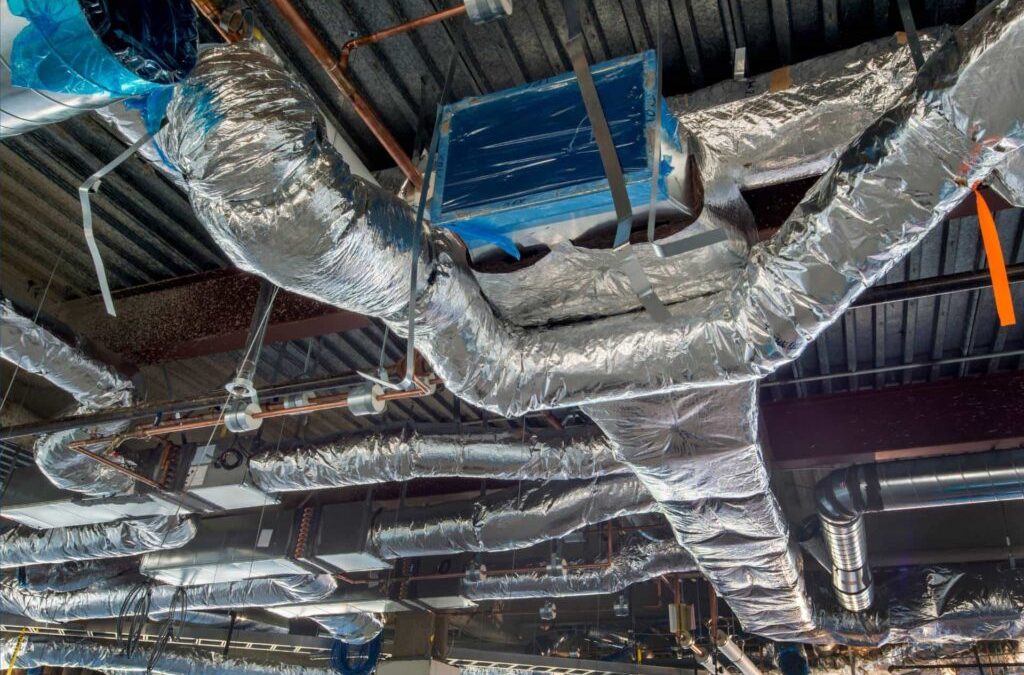-
Fiberglass Insulation:
A popular kind of insulation for ductwork is fiberglass insulation. The process begins with the weaving of glass fibers into a mat, which is subsequently compacted into a dense substance. When it comes to thermal performance, fiberglass insulation is well-known for its ability to keep heat in and outside air out of ducts. Not only is it inexpensive in comparison to other insulation options, but it is also simple to install. However, without the right safety measures in place, fiberglass insulation has the potential to irritate the skin, eyes, and respiratory system. It also doesn’t do a good job of blocking out noise compared to other insulating options.
-
Application:
Fiberglass insulation works well with HVAC systems in homes and businesses. Ducts made of it can be arranged in a variety of ways, including spiral, round, and rectangular shapes. Ducts exposed to unconditioned air are typically insulated with fiberglass in basements, crawl spaces, and attics. Additionally, it is utilized in both new-build and retrofit applications to enhance comfort and energy efficiency.
-
Considerations:
Remember to wear safety gear like goggles, a dust mask, and gloves when installing fiberglass insulation. This will help prevent skin irritation and respiratory difficulties. To further guarantee excellent performance and avoid air leakage, fiberglass insulation needs to be correctly sealed and supported. To choose the right thickness for their climate and energy efficiency goals, homeowners need also think about the R-value of the insulation.
-
Foam Board Insulation:
Duct insulation using foam board is another common option. Panels of firm foam, usually composed of polystyrene or polyurethane, make it up. Foam board insulation has the advantages of being lightweight, easily cut, and duct-installable. Foam board insulation helps prevent heat transfer in the ducts thanks to its strong thermal resistance, which is one of its key advantages. Mold and mildew can’t develop in the ducts because it’s water-resistant. On the other hand, foam board insulation isn’t always the most budget-friendly, and it’s not always easy to work with in confined areas due to its lack of flexibility.
-
Application:
Foam board insulation finds widespread application in basements, crawl spaces, and attics due to the restricted space available in these places. For extra insulation, it can be put either directly onto the surface of the ducts or between the joists or studs. A continuous layer of insulation without gaps or cavities is provided by foam board insulation, making it appropriate for insulating ducts in unconditioned environments as well.
-
Considerations:
For foam board insulation to work as well as possible, it must be installed correctly. To ensure a snug fit around ducts and other obstacles, homeowners should measure and cut the insulation panels with care. To stop air from escaping, use tape or caulk to seal any seams or edges. In order to keep the insulating characteristics of foam board insulation intact over time, it is important to keep it away from moisture and sunlight.
-
Reflective Insulation:
One kind of insulation is reflective insulation, which consists of a reflective material (like aluminum foil) laminated to a substrate (like kraft paper or polyethylene bubbles) for further protection. One way reflective insulation helps keep heat in and cold air out of ducts is by reflecting the sun’s rays back into space. Duct insulation made of reflective material is a popular alternative due to its portability and ease of installation. When compared to other insulating options, it’s also rather cheap. Reflective insulation has its uses, but it might not be the best choice for every situation because it doesn’t cut down on heat transfer as much as other insulation options.
-
Application:
Reflective insulation is a popular choice in hot regions due to its ability to significantly reduce radiant heat gain. Putting it in an unconditioned space, such as an attic or crawl space, will lessen the amount of heat that escapes through the ducts. When combined with other insulation materials, reflective insulation can further improve thermal performance and occupant comfort.
-
Considerations:
Keep an air gap between the duct surface and the reflective insulation while installing it for the best reflecting qualities. Radiant heat should be directed away from the ducting by installing the insulation with the reflective side facing outward. Properly sealing seams and edges is another important step homeowners should take to keep air leakage to a minimum and keep insulation effective.
-
Mineral Wool Insulation:
Mineral wool insulation is very effective in blocking sound and heat. Being crafted from either natural rock or blast furnace slag, it offers a sustainable and eco-friendly alternative. Insulation made of mineral wool has several potential uses due to its resistance to fire, water, and insects. It is perfect for ducts that transport hot air since it can endure high temperatures without losing its insulating properties. In addition to enhancing indoor comfort and lowering noise transmission through ducting, mineral wool insulation offers exceptional sound absorption.
-
Application:
Mineral wool insulation finds widespread usage in commercial and industrial HVAC systems that must withstand high temperatures or are subject to fire hazards. It is typically attached to ducts that transport heated air, like those that lead to boilers or furnaces. For home theaters and recording studios, mineral wool insulation is a great choice for outstanding thermal and acoustic insulation.
-
Considerations:
To guarantee the safety and efficacy of mineral wool insulation, it is vital to handle and install it properly. When working with mineral wool insulation, homeowners should take precautions to avoid skin irritation and respiratory difficulties. Make sure to seal all seams and edges correctly.

